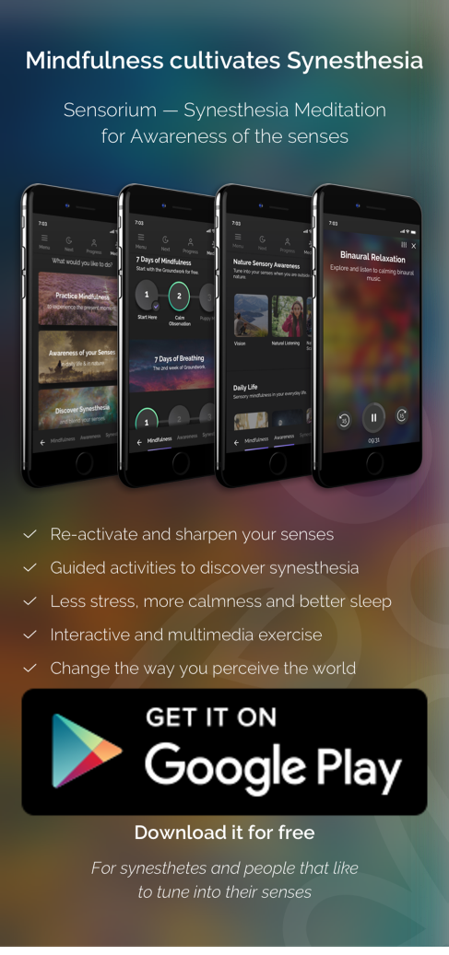Types of Synesthesia – Blend All Your Senses
There are over 80 different types of synesthesia described by science. Synesthesia means to blend the 5 senses. Examples or synesthesia are seeing sounds in colors or touching smells.
Also, concepts such as letters or numbers may evoke the perception of color. This co-activation is called Ideasthesia.
We have more channels of perceptions than our 5 classical senses. For example, emotions, how your solar plexus feels, the position of your body in space or the feeling of being hungry. Those also may trigger synesthetic experiences.
In this article, you will…
- get an overview of the different types of synesthesia.
- see some examples of synesthesia.
- do some activities to explore your synesthetic abilities
- learn more about how to train your synesthesia.
You prefer experiencing synesthesia over reading about it?
Well, then jump right into your journey of perceiving synesthesia.
There are over 80 types of synesthesia described by science
Nearly every combination of sensory experiences or cognitive concepts is possible.
Seeing music as colors is one form of synesthesia. Perceiving letters as personalities is another one, or seeing numbers in color. Even hearing colors or touching smells.
Many people are not aware of Synesthesia.
More research is conducted, and synesthesia gets reported more frequently in the media. Still, many people are unaware of their synesthetic abilities.
There are several reasons why there are many unaware synesthetes. One is the lack of perceptual sensitivity or absence of sensory awareness.
Meditation cultivates Synesthesia
A study is pointing out, that meditators are more likely to experience Synesthesia. And the synesthesia research Pioneers Prof. Eagleman and Prof. Cytowic put it this way:
Don’t take LSD, but learn to meditate if you hope to experience Synesthesia.
Synesthesia Meditation
Discover all types of Synesthesia! “Learn to meditate if you hope to experience Synesthesia.” In the Sensorium, you find over 150 exercise of Synesthesia Meditation.
It is a mix of traditional mindfulness and synesthetic explorations. Discover and become familiar with the different types of Synesthesia.
Some types of synesthesia are more frequent than others.
Some types of synesthesia are more common than others. Grapheme-Color synesthesia (colored letters) or chromesthesia (music in colors) appear to be more frequent than others. For example tasting words is less often reported. People with synesthesia are mostly aware of more than one type of synesthesia.
Certain types are also more studied than others. Some forms of synesthetic experiences are more straightforward to express with words. It is more comprehensive to talk about colors of letters than the sound of a color.
Most of us know what the color “red” means. Meanwhile, talking about the sound of a color is more difficult. Not everybody knows the keynotes of music.

Synesthesia, see it as an umbrella term.
The different types of synesthesia are sometimes entirely different in their sensory nature. Even though some types of synesthesia may sound exotic, it may be that you resonate with it as well. So take also the opportunity to discover and increase the mindful synesthetic awareness.
Synesthesia and Ideasthesia – A broad distinction
In a strict sense, synesthesia is when one sense elicits other senses.
Ideasthesia is when a concept or an idea triggers a real sensory experience. Such as the letter “E” may be perceived in a color. A number or a letter is not a real sense. It is an abstract thought or idea to which a person assigns a color.
Sometimes, it can even be that a concept triggers another concept. For example, a letter can have a gender. Both the letter and the gender are not a sensory experience. Letters and genders are rather “ideas.”
Synesthesia: Our five classical senses blend together
Our 5 classical senses involve hearing, smelling, touching, seeing and tasting. We have more than 5 senses.
Even the sense of touch consists of several senses. Touch (or the skin) perceives pressure, temperature, and pain, for example. So talking about the five senses is simplified and therefore we will call it classical senses.
Let’s focus on the sensory types of synesthesia. For people that resonate with synesthesia, the 5 senses blend. Think about any combination of the senses; it could be a form of synesthesia.
In the garden of synesthesia, you find the “SenseSphere.” In the SenseSphere” you will mix all your senses through synesthesia meditation. Such techniques allow you to explore the different types of synesthesia with synesthetic mindfulness.
Let’s have a look at some synesthesias of our five senses.
Chromesthesia – Seeing sounds in colors
This form of synesthesia is about sound and color. Seeing sounds such as singing birds or a car honking. Or music that elicits colors, motions, and shapes. Those experiences vary from person to person.
There are general tendencies about the perception of sound. Higher sounds are rather associated with a small shape and a bright color. Deep-pitched sounds are rather dark and large. These associations apply to almost everybody, even for in chimpanzees.
Sounds do not only evoke colors. Music can evoke the perception of movement, luminance, or smells and tastes, too.

Auditory-Tactile Synesthesia is touching sound.
Auditory-Tactile Synesthesia is when hearing a sound co-activates the perception of a texture. It feels as if you can touch the music with your finger.
There have been some contemporary artists, that state to be synesthetes. Such as Lady Gaga, Billy Joel, Tori Amos or Pharrell Williams, to name a few.
In the section “SoundScapes” it is all about Sound. Find many different exercises to deepen your mindful synesthetic experiences. Listen to sounds and discover their colors and shapes. Or get a pen and start drawing it!
Other Sensory types of Synesthesia
Seeing: when colors start to sing
Our sense of vision can trigger other senses. Colors or motions can evoke the sense of a sound or even a smell or a taste. You can see an interesting experiment in the video below. Can you hear something?
Hearing Motion – synesthesia diagnosis demo
Do you hear anything when viewing the moving dots? Play the movie repeatedly for best effect. Some people hear sounds when seeing this movie (and also when s…
“This visually evoked auditory response” is called Hearing-Motion Synesthesia. A new study claims that 22% of human beings may have this particular type of synesthesia.
Or try this one:
rope jumping electricity pole
yeah… i saw this on deviant art. XD
Tasting & Smelling: Let each meal be a symphony.
Unfortunately, many of us tend to eat too fast. Especially given that the experience of taste and smell can evoke other senses such as colors, shapes.
Odors have direct access to our emotion and memory areas of the brain and may be one of the oldest senses of organisms.

In the SenseSphere you find exercises about the synesthetic experiences of smell and taste. They are interactive. Go to your kitchen and get some items rich in sensory experiences.
Smell & Taste
If you are not convinced yet, that also non-human animals may experience synesthesia, consider this:
Are rats synesthetes?
Ratatouille – Synesthesia – HD – FX Animation by Michel Gagné
In the Fall of 2006, I was contacted by Brad Bird to create a series of animated vignettes for his movie Ratatouille. The concept was to design and animate a…
Tactile Synesthesia – With your fingers eye
The sense of touching is diverse. Our skin is our biggest organ. It contains several different senses: Pressure, pain, and temperature.
Touching a surface can trigger the experience of shapes and colors. Also, sensual stimulation, such as a massage, can be enjoyed with synesthetic experiences.
Discover the colors of a feather on your neck. Practice Synesthesia Meditation. It trains your mind to remain on the enjoyable perceptions in the present moment.
You find exercises on touch in the SenseSphere. If you want to try out a synesthetic feather experience, try this.
Perceptions of our Body and Mind
Our body and minds are the sources of many different perceptions. Hence, there are many types of synesthesia to explore. So, let’s discover the sensory experiences of your mind and body.
Exteroception – where is your left hand?
You need to know where your left hand and your right foot are located in space, for safety and survival. Where are they now? It is intuitive for you, to know where your limbs are right now. Thanks to exteroception. Nerve cells attached to your muscles send the information where your hands are to your brain.
The position and the movement of your left leg can stimulate other senses. Shapes, colors or tastes and smells, you name it.
Or perceive the colors of your body by doing sports, dancing or walking.
In the “Daily activity” section you find exercises involving movements.
Interoception – silver breathing and green tiredness.
Interoception is the experience of internal sensations. Such as being hungry, feeling your heart rate, breathing or the urge to visit the toilet. See it as internal perceptions of your body.
Less often you can read about types of synesthesia that involve interoception. They can evoke other senses such as the perception of colors, shapes, tastes or a sense of touch.
Synesthetic breathing is an essential component of your mindfulness training; you will find exercises in the path of mindfulness. Furthermore, in the garden of synesthesia, we have the category “me and my environment.” Explore more about synesthesia of your internal body perception.
Synesthetic Body Sensations
So, you see why the classification of the five sense falls short to describe all our perceptions.
Emotions, Feelings, Moods – It feels so green in my stomach area
Tough emotions, feelings, and moods are kind of similar in nature, they are very different. Emotions, feelings, and moods can all evoke synesthetic experiences. Falling in love, breakups, being grumpy in the morning or feeling tired. They all may trigger the sense of colors, shapes, tastes or even sounds.
Synesthesia Meditation is also a tool to cope with strong emotions, feelings, and moods. When you realize that “brown” grumpiness crawls up your throat, it may be a reminder not to give it too much power.
And Synesthesia Meditation helps also to enjoy the positive emotions, feelings, and moods a little bit more, to get more out of the present moment.
Exercises on awareness of emotions, feelings, and moods you also will find in the Sensorium category “me and my environment”. The training to become aware of moods is regularly involved in the path of mindfulness.
Pain
There are different types of pain. One is short and sharp and another is long lasting chronic one. Pain can also be a source of synesthesia. For example, hitting our little toe in a door may result in a spiky flashy bright visual perception.
When you shift your attention away from the pain and onto the synesthetic perception, the pain may cease a little bit. It is just another perception. Perceive it in colors and without any judgments.
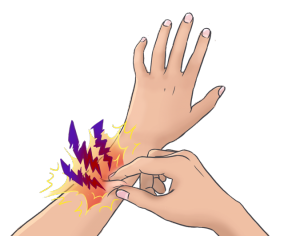
Pain Color Synesthesia: Feeling strong sensations, such as pain, are perceived in shapes and colors.
In the Sensorium, there is the category Pain in the “me and my environment” section. We begin with having a look at the colors of remembered pain. In another exercise, you will pinch yourself to experience “pain.” And we will have a look on mirror Pain Synesthesia (see below).
Synesthetic Pain
Pain Synesthesia & Mirror Touch
Mirror-Touch Synesthesia and mirror pain synesthesias are newly described types of synesthesia.
Mirror neurons are neurons that fire when you watch someone acting. If you see somebody grabbing a glass of water, your neurons for grabbing, fire too. Just by seeing the action, the mirror neurons are activated.
Mirror neurons are essential for learning, especially for newborns. They imitate the behavior of others in their environment.
Mirror-Touch Synesthesia is a type of synesthesia. When you see somebody being touched you may have the experience of being touched yourself.
Is it challenging to watch horror movies? Mirror pain synesthesia is a phenomenon where seeing somebody in pain evokes the feeling of pain too. Maybe you have a hard time enjoying horror movies because of this type of synesthesia.
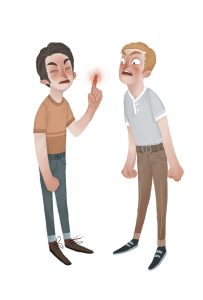
Read more about “Mirror-Touch and Mirror-Pain Synesthesia.”
In the Pain section of “me and my environment” we provide a video to allow you to perceive that first hand. Be aware; it may hurt a little. 🙂
Ouch, This May Hurt A Little
Ideasthesia – Concepts trigger sensory experiences
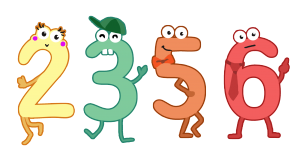
Grapheme Synesthesia – What color is Letter “A”?
Grapheme-Color Synesthesia is perceiving letters and numbers as colors. Letter “A” can be red or blue, or whatever color. These colors remain consistent over time. It is one of the most common types of synesthesia and is studied extensively.
If you want to learn more about Grapheme-Color synesthesia, we have covered this type of synesthesia in one of our articles. If you feel like doing a quiz, click here. Or try our free exercise about Letters and numbers.
Calendar Synesthesia – The color of Wednesday and the shape of a year
What is the color of Wednesday? Or the month April? Calendar synesthesia is similar to the type of Grapheme-Color Synesthesia. Except it is about time units such as weekdays and months. They can be perceived in colors, personalities, and gender.
The months of the summer are often brighter than the months of winter. And days of the working week tend to be darker than the weekend. How is it for you?
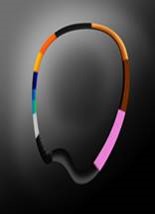
Out in Space – Spatial Sequence Synesthesia
Spatial sequence synesthesia is a form of synesthesia, where the numbers or the alphabet are spatially arranged in your mental space. It is like a mental map. This phenomenon is also called number- or letter form synesthesia. Time can be the perception of a shape or a sequence.
Different abstract ideas are arranged in space. People with synesthesia “look” at it. Sometimes their gaze follows the sequence or the sequence itself moves.
Being aware of this kind of synesthesia is tied to cognitive benefits. One study found that synesthetes have visual short-term memory advantages.
Number Form – the arrangement of digits in space
Counting the numbers may evoke the feeling of the numbers arranging in space. There are many different forms of this arrangements. How they are perceived also depends on how high the numbers are.
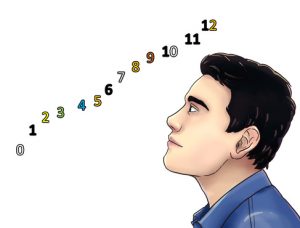
Letter-Form Synesthesia – the alphabet in the mental space
The letters of the alphabet are also arranged in space. Some seem to be bigger than others. Sometimes, the way how somebody learned the alphabet many years ago, is still represented in the letter form synesthesia.
The popular song “ABCDEFG” for example, has found its way into the arrangement of this synesthete on the picture.

Calendar form synesthesia – Year is an oval
Some call it calendar synesthesia. A week or a year are perceived as a shape that remains the same more or less during one’s.
Also, the course of your lifetime (from the birth to now) may be perceived as shapes.The years of the past arrange into a form.
It seems to be one of the most frequent synesthesia. Estimations say that up to 1 out of 5 people may have this type of synesthesia.
These forms are individual for each person. For some, the year is a line, an oval, an arc or a spiral, just the name a few. When observing these forms, the gaze wanders or the whole shape moves. Some days may be bigger than others of the week.
Even though in the mental space it all makes sense, drawing it reveals it is challenging to bring it onto paper.
These shapes can help with visual short-term memory or when synesthetes plan their schedules.
What about your perception of sequences? In the Sensorium, you can find several different exercises about it. Check out the “Time” Exercise. Or maybe you want to attempt to draw it? Try it out!
Ordinal linguistic personification – Number “4” is open-hearted
Letters and numbers may also be perceived as having a gender and a personality. For me number 3 is a cheeky boy and number 4 a good-hearted mother. They interact with each other, especially when doing calculations. Multiplying 4*6 = 24, it was the story of number 4 being forced to marry number 6!
The personification of letters and numbers is called ordinal linguistic personification, or OLP.

Letters and numbers may have a gender and a personality. They can either be pleasant or not so pleasant. Synesthetes do like some digits better than others. Similarly, as you like some of your peers more than others. Letters that are more frequently used in language seem to be more “social” than those who are used less frequently.
Sounds kind of weird? Well, try it your yourself. It may be more intuitive than you think. Here is a free exercise about letters and numbers. Make friendship!
Lexical-gustatory Synesthesia – “Derrek sounds like earwax.”
This type of synesthesia has been reported with J. Wannerton. He perceives words as gustatory experiences. Famously is his map of the London Tube where he changed the name of each station into his gustatory synesthetic experience.
Though it is a less common form. Try it out!
Which of the three London stations is the sweetest for you? And which one the most bitter?
Plaistow
Neasdon
Walthamstow
Synesthesia Meditation: Integrate the types of synesthesia in your daily life.
There are many types of synesthesia. And many people have the potential to experience it. But most of them are not aware of it. To perceive synesthetic experiences, you need to shift your attention to it.
Mindfulness is the process to shift attention to your senses. This allows you to be in the present reality of a synesthetic moment. In the garden of Synesthesia, you can discover many different types of synesthesia.
The exercises help you to learn how to access a mindful synesthetic awareness. Along the path of mindfulness, we train the process of becoming aware of your senses. In this way, synesthesia becomes intuitive in your daily life. Just 10 minutes per day are enough to change the way you sense the world.
Take home message
- Synesthesia is when a sensory experience (e.g., Music) activates another sensory experience (e.g., Color)
- Ideasthesia is when a concept or an idea (Letters) evoke a sensory experience.
- There are many different types of synesthesia to discover. Some are more obvious than others.
- Synesthesia is subtle. If you do not pay attention to it, you won’t perceive it.
- Being aware of synesthesia may have cognitive advantages.
What next?
Practice Synesthesia Meditation for free
Go to the free gateway to start now your mindful synesthetic journey.
3 Hour of Free Content
Read more
Here on the blog, you find more resources. Or have a look at Sean Day’s list.
Talk about it.
Tell your friends and family about synesthesia. They may be unaware of it, and you can be the “gate opener” and possibly change their sensory perception forever.

